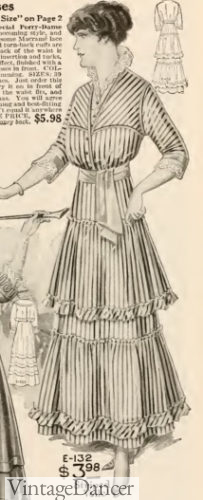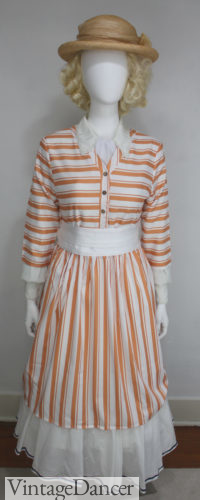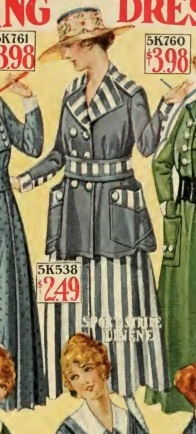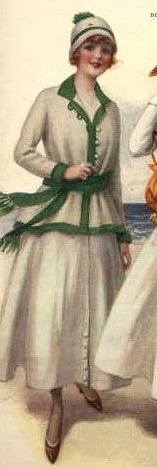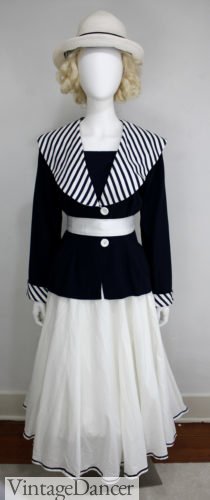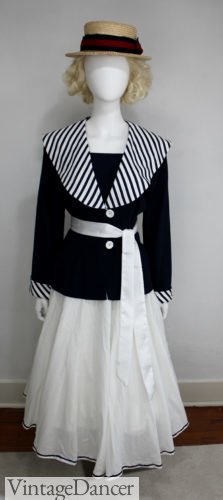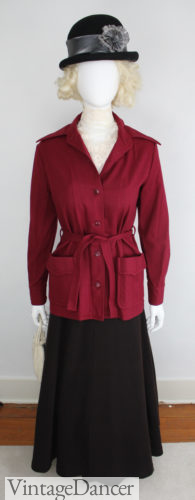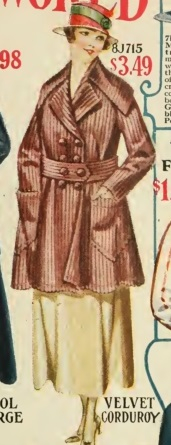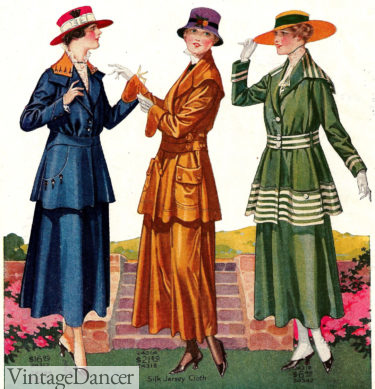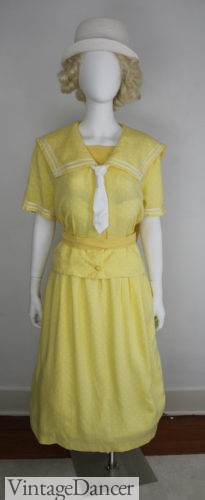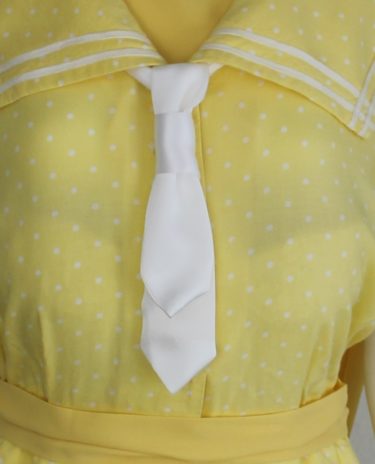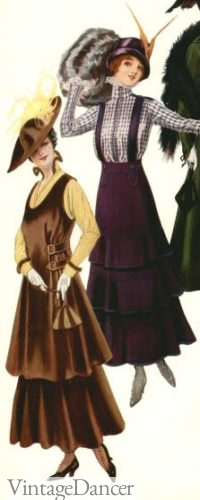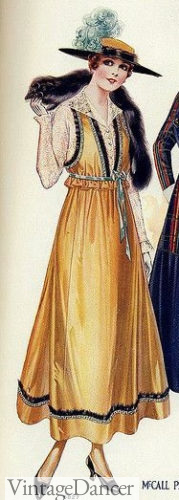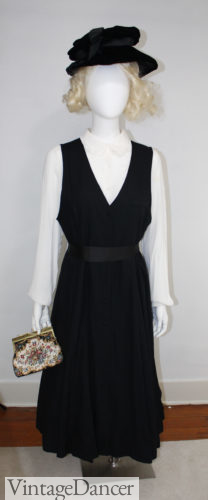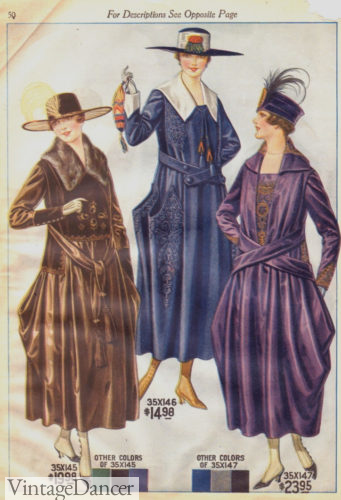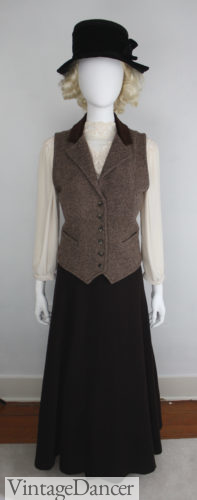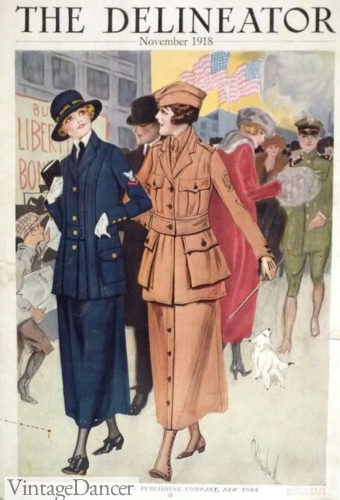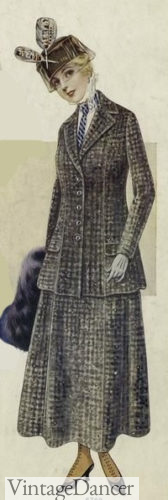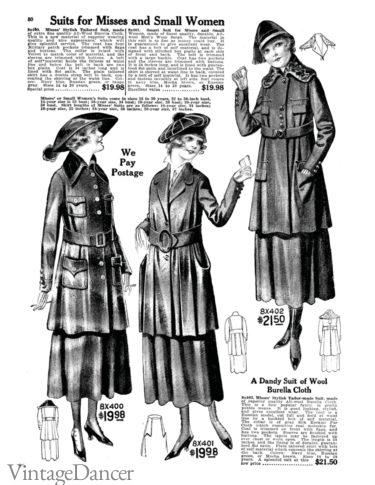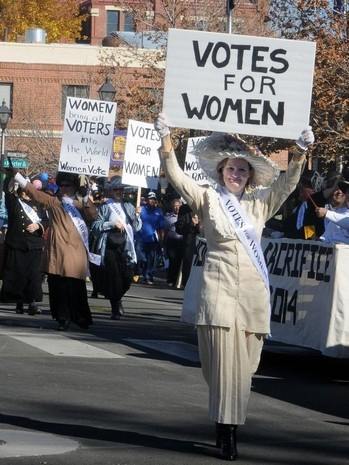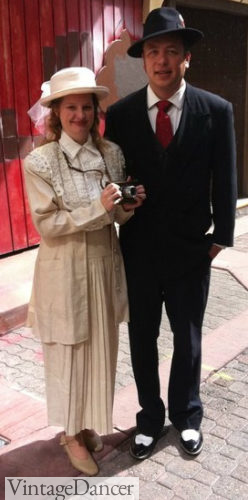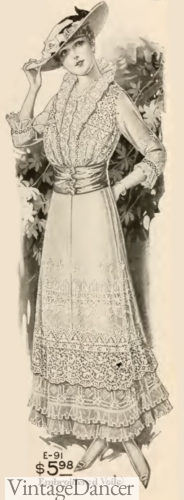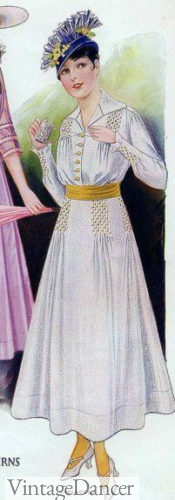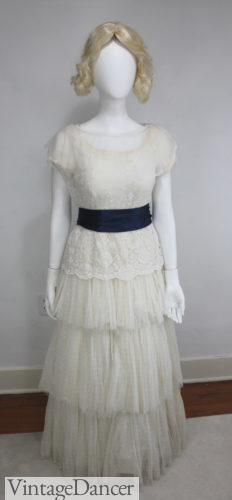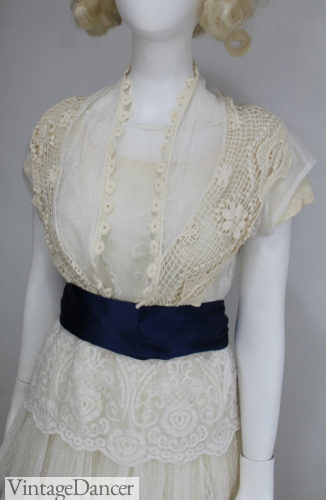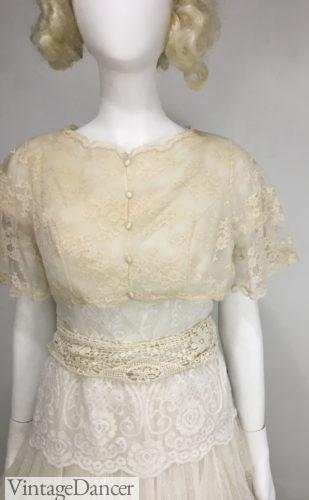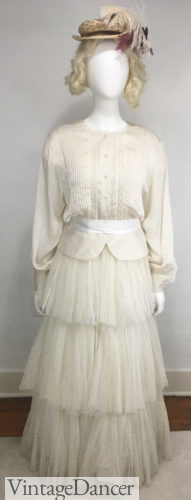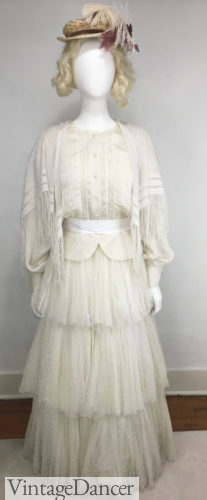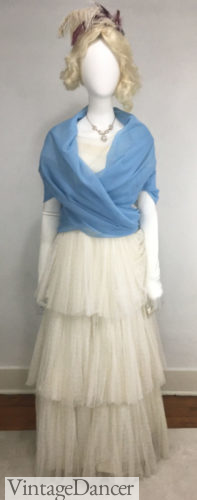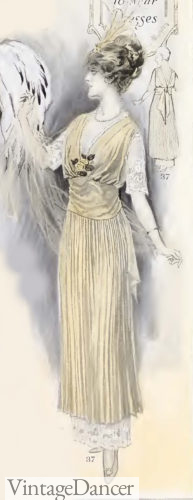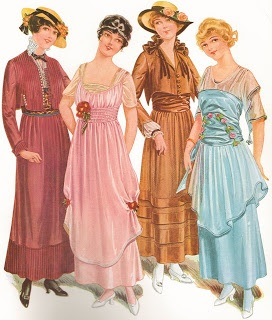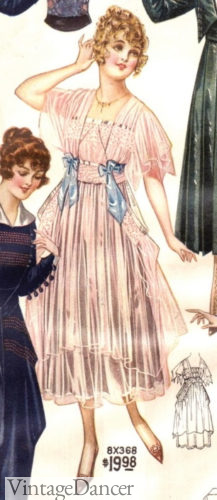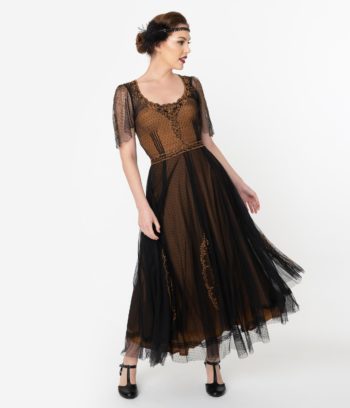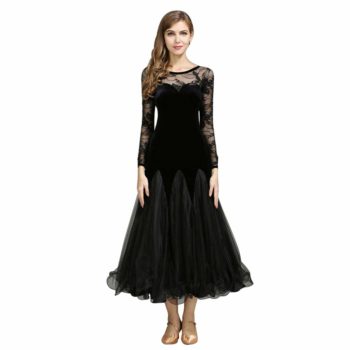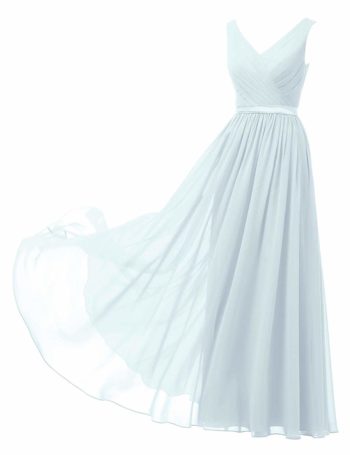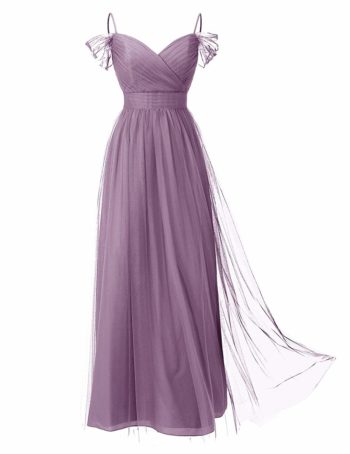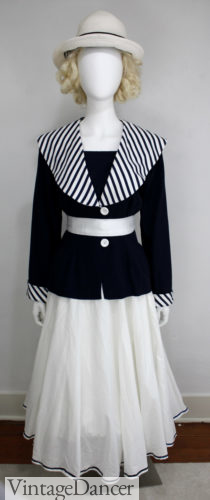
DIY 1916 outfit
After the Titanic sank in 1912, Edwardian fashion took a shift away from the ultra-slim silhouette to a roomier, easier, less fussy style. Coupled with the onset of World War I in 1914, civilian fashion reflected the need for practical clothing. It is a time period most historians and historical costumers overlook in favor of the prettier 1910s clothing or fun 1920s clothing. Yet I have been fielding a few questions about the 1914 to 1918 timeframe, specifically how to make or buy an outfit on a budget.
Since I love thrifty costuming, I was a little excited to hit my local shops and see what I could create. I found some amazing pieces that required little to no sewing and paired them with some accessories I purchased (belts and sashes), plus hats and shoes I already owned. Most of these clothes you may or may not find in your local thrift stores, but these outfits should get your creative mind thinking and seeing the possibilities of what you can make.
Dresses – Daywear
The majority of dresses from 1914 to 1918 and up to 1922 were one-piece long gowns with a fuller skirt, a belt or sash at the natural waist, and large collars in a variety of shapes. Dresses had modest tops and long sleeves in keeping with the morals of the day.
The difficulty I had with finding a basic dress to work with was they needed ample sewing or trimming to create the correct look. This wasn’t something I wanted to spend my time on just yet, so I looked into pieces I could layer and accessorize instead of sew.
My dear friend Tina, however, made the dress on the Right by starting with a 1980-1990s simple gingham cotton dress and trimming it with a lace collar, lace piping detail on the bodice, and lace trim on the hem. The overall look is perfect for the 1910s. If you have some basic sewing skills, you too can upgrade a plain long dress into an Edwardian-esque costume. Tina’s costume on the Left is another example of a dress, this one made from bedsheets using a reproduction sewing pattern. It is a clever and economical idea!
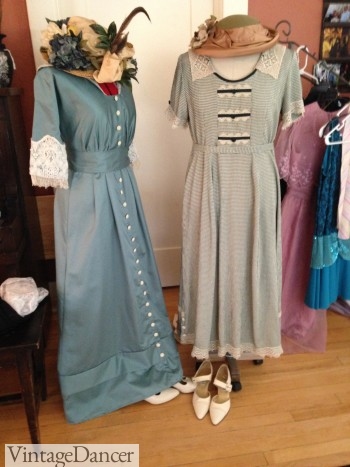
My friend’s two thrifty dresses. (L) A bed sheet was used to sew this dress from a 1900s pattern. (R) An ’80s prairie type dresses was trimmed with lace to give it a bit more 1910s day dress style. (Credit to Tina Davis)
I would like to attempt to make an upcycled dress like Tina’s once I find the right plain dress to start with. In the meantime, I found some other dresses that I layered over blouses that too make some authentic-looking costumes without a speck of sewing. Most of these designs lean towards the casual/summer/sporty styles which used more layering or contrasting tops and bottoms instead of the one-piece day dress.
Striped Summer Dress
My first costume is a striped summer dress layered over a white circle skirt and a white button-down blouse. The skirt came with blue sequin trim on the edge that you will just have to ignore for a moment. The blouse had a large collar (yeah!) and wide sleeve cuffs (double yeah!). For the belt, I used a white satin skinny scarf and wrapped it several times to create a wide waistband popular between 1915-1919. I then added a round brim straw hat and shoes that would be either white lace-up boots or slip-on pumps.
I referenced these two images from 1915 and 1919 to give me a general direction as to how to tie the belt and what kind of blouse to layer the dress over. If only the dress was long enough, it would have been even more perfect. As is, it has a summertime beach-going feel.
- 1915 Striped tiered dress
- My striped summer dress
- 1919 striped dress
Seaside Sailor Dress
The next costume is my favorite of the bunch. You have no idea how excited I was to find a blue striped 1980s blouse-jacket with huge shoulder pads and gaudy brass buttons. I knew immediately it was exactly what I needed to make a seaside sailor outfit inspired by these outfits from 1915-1916:
- 1915 blue and white striped jacket and skirt outfit
- 1915 striped jacket over white skirt
- 1916 “vacation” outfit
I removed the huge shoulder pads, replaced the brass buttons with white buttons, and added a sash tied two different ways worn over the white skirt from above. In this case, the blue sequin trim doesn’t look out of place, although I will probably remove it later. A proper tea-length petticoat provides the A-line fluff needed for this time period. I paired these outfits with a white straw roll brim round hat and a boater hat. For shoes, I would choose white dress pumps or two-tone Oxfords for a sportier take.
I LOVE, LOVE, LOVE this outfit. Now I only need an event to wear it to.
- Outfit with sash band and white straw hat
- Outfit with boater hat and loose sash belt
Two Piece Outfits
The second jacket and skirt outfit came about from another very lucky find- a 1960s Pendelton wool jacket with a wrap belt. The collar on this jacket looks exactly like some of the collars on 1915 dress jackets. The big pockets are perfection as well. Added over a high neck lace blouse and brown wool skirt with a pair of boots, it is a perfect Edwardian fall fashion outfit.
- 1970s does 1915 jacket with skirt, blouse and and hat
- 1915 jacket over contrasting skirt
- 1915 jackets and matching skirts
Here is another similar jacket + skirt look. This one reminds me of the Old Lady Grantham on Downton Abbey. The jacket is painted satin with a velvet collar. Since it feels more luxurious, I paired with with a jet black Edwardian style necklace. I wish I had a matching belt. If I leave the belt out entirely, it takes on the shape of the early 1920s sack jacket.
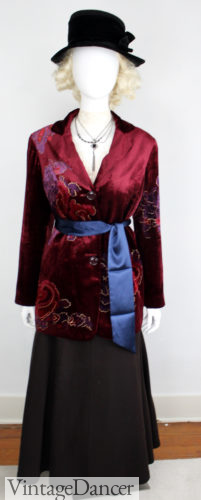
Late teens outfit with a fancy jacket, lace blouse, skirt and sash belt.
Sailor Dress
Going back to the ocean, I found an adorable yellow polka dot 1980s sailor dress that was practically perfect as is. I only needed to add a yellow belt and a hat to complete this look. However, something was missing. One key feature in many 1914- 1916 sailor dresses was a sailor necktie. I used some white ribbon to mock tie a sailor knot necktie and voila! It was done.
- 1916 sailor dress with necktie
- My yellow sailor dress with DIY necktie
- Necktie made of white satin ribbon
Jumper Pinafore Dresses
Thanks to this 1914 outfit idea, I have been keeping my eye out for a jumper dress/pinafore dress to turn into a sporty, casual1915-ish WWI civilian outfit. Looking at these jumpers as inspiration, I found there was a variety of shapes from high and modest to very low front jumpers. Each was paired over a white or colored blouse with a high collar.
- 1915 Fall Jumper Dresses
- 1915 Spring Jumper
- 1915 gold jumper
- 1915 plaid jumper
- 1915 pleated jumper
For my outfits, I found several jumpers/pinafores to use, each with its own style. The first one is a V neck black jumper that is simple yet effective. The second is a layered sporty look with big buttons on the straps and a tie loosely hanging off-center in the front, which is something I have seen on a few other day dresses from 1917. Some of the casual jumper dresses above use a matching vest with a skirt to create a one-piece looking jumper dress — yet another idea I want to try.
- A simple black jumper dress over white blouse
- Lower middle class type jumper dress outfit
- 1917 dresses with unique belt ties
One more easy, casual, sporty outfit combined a skirt (or riding jodphurs) and a vest over a blouse. It is something that could have been worn for bicycle riding, horseback riding, hiking, and other rustic outdoor activities.
- WW1 vested sport outfit
- 1915 riding outfit
Walking Suit
During the War, many women took to paid or volunteer occupations that were previously occupied by men. For this new role, women’s suits or walking suits exploded in popularity and practicality. Wool suiting was durable, cheap, warm, and masculine enough for her man-like tasks, yet tailored to feminine lines. They continued to be popular after the War as women fought for the right to vote during the Suffragist movement.
- 1918 walking suits
- 1915 wool check suit
- 1917 walking suits
For my costume, I attempted to re-create the movie suit Diana from Wonder Woman wore in 1918 London. I used a full check skirt, white-collar blouse, herringbone jacket, and wide leather belt. Ideally, the jacket and skirt should match, but for this DIY costume, I think it turned out rather well.
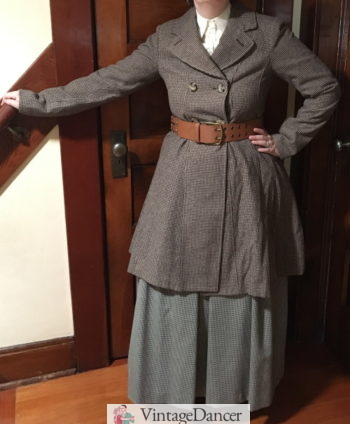
My 1918 walking suit outfit
Another suit I wore for a Suffragette march was a lucky find: a cream linen 1980s Jessica McClintock pleated skirt and jacket (with classic ’80s white lace lapels.) I didn’t need to do anything to the suit to make it work for the event other than add a “Votes for Women” sash. Gotta love the 1980s Victorian/Edwardian revival for easy DIY costuming!
- My 1890s Suffragette Costume Made from a Linen 1980s Jessica McClintock Suit
- Another view of the suit for a 1919 event
Tea Dress
One of the most popular themes for a 1910s Edwardian event is a tea party. Wearing a white tea dress seems almost mandatory for daytime spring or summer gatheirngs. White dresses were not only worn for tea but as evening summer dresses, or dresses for those living in the hot south. White embroidered voile, satin, net, and lace-trimmed dresses were extremely popular during the War years:
- 1915 white summer dress
- 1915 lace party dress
- 1915 day dress
- 1915 lace tea dress
All white or all black outfits seem to be much easier to put together than a colored outfit. There are plenty of white long lace dresses online. For my tea dress, I looked at all of my white/cream lacy clothes and mixed and matched dresses, sheer blouses, sashes, jackets, and scarves to create a few potential outfits. Ideally, tea dresses should have longer sleeves (at least below the elbow) unless it is for eveningwear.
- Cream tea dress with blue sash
- I layered a cream lace scarf over the dress and a sheer top to create this dress bodice.
- A lace bolero works well too
- Another daytime tea outfit with a blouse
- adding a shawl
- Evening dress with a draped piece of blue chiffon fabric
Evening Dress
The final outfit is an evening dress. Evening dresses during the war years looked to ballerinas for inspiration. The dresses were light pink and pastel blues with wispy layers, a wide sash belt, and decorations of faux flowers and silk bows. Remember that during the War, there were hardly any formal events to attend. Most women continued to wear older styles of dresses (1910-1913), even after the war ended, in order to conserve expenses. Even at Downton Abbey during and after the War, the ladies were NOT wearing current fashions. Sybil remarked in 1919 wearing a 1913 gown, “I am wearing my gowns out.”
- 1915 evening dress with lace underlayer and flower accent at bust
- 1915 pink and blue party dresses with sheer sleeves and flower accents
- 1917 ballet style party dress with bows at the waist
I couldn’t find the right clothing at my thrift stores, but I do have some suggestions for how to use current eveningwear and make it fit the 1914-1918 time frame.
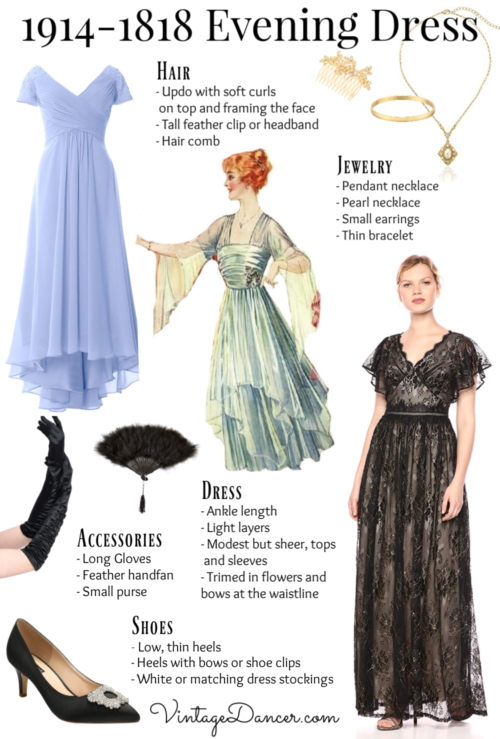
Evening Dress Guide
The following dresses are pretty close as is because of the light and airy materials and ballet gown shape. To make them a bit better, you could accent the waistline with flowers or bows, gather up the top layer a bit on the sides to create a fulled effect, or add sleeves to the top with an underlayer lace blouse or an overlayer with a light shawl/wrap. Find this style of evening dress here. Another option is to look at 1950s evening dresses – many are in the same tulle ballgown/tea gown style.
- This dress is lovely as is. You could add a cluster of flowers to the waistband.
- This ballgown just needs some kind of waist accent- a bow, flowers, or sash.
- This sleeveless gown needs sleeves. Layer it over a lace or sheer blouse or wrap up in a light evening shawl. I might gather up the top skirt layer on the sides and secure with bow to give it a 1916 look.
- Similar to the blue gown it could use sleeves or perhaps pretty bows over the shoulder straps.
For accessories, add simple jewelry such as a pearl necklace or thin gold necklace with a pendant. Add a hair clip or single tall feather in your updo. A feather hand fan is fun to carry and flirt with, and long gloves are a must. A small pouch purse or beaded bag will hide your cell phone well. And for shoes, simple pumps will be fine. Or, add shoe clips for sparkle or flat bows for interest. If you need flats, you can find pointy toe bow flats fairly easily.
More outfits:
1910-1915 – Titanic inspired outfits to DIY
1920s Downton Abbey Outfits – 1920-1925 outfit ideas
Victorian Dress outfits – 1840-1900 outfit ideas
That concludes the outfits I have created so far. Is there another look you need? Let me know in the comments and I will get to work!
Debbie Sessions has been teaching fashion history and helping people dress for vintage themed events since 2009. She has turned a hobby into VintageDancer.com with hundreds of well researched articles and hand picked links to vintage inspired clothing online. She aims to make dressing accurately (or not) an affordable option for all. Oh, and she dances too.
